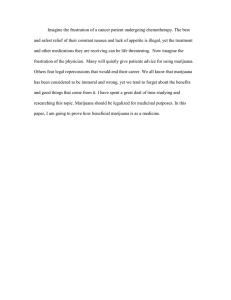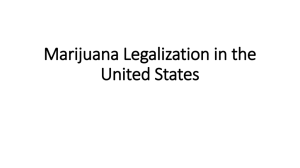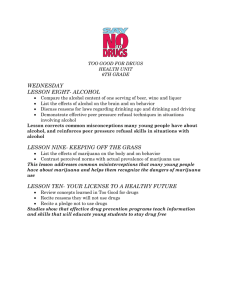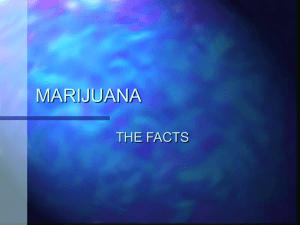Revision
advertisement
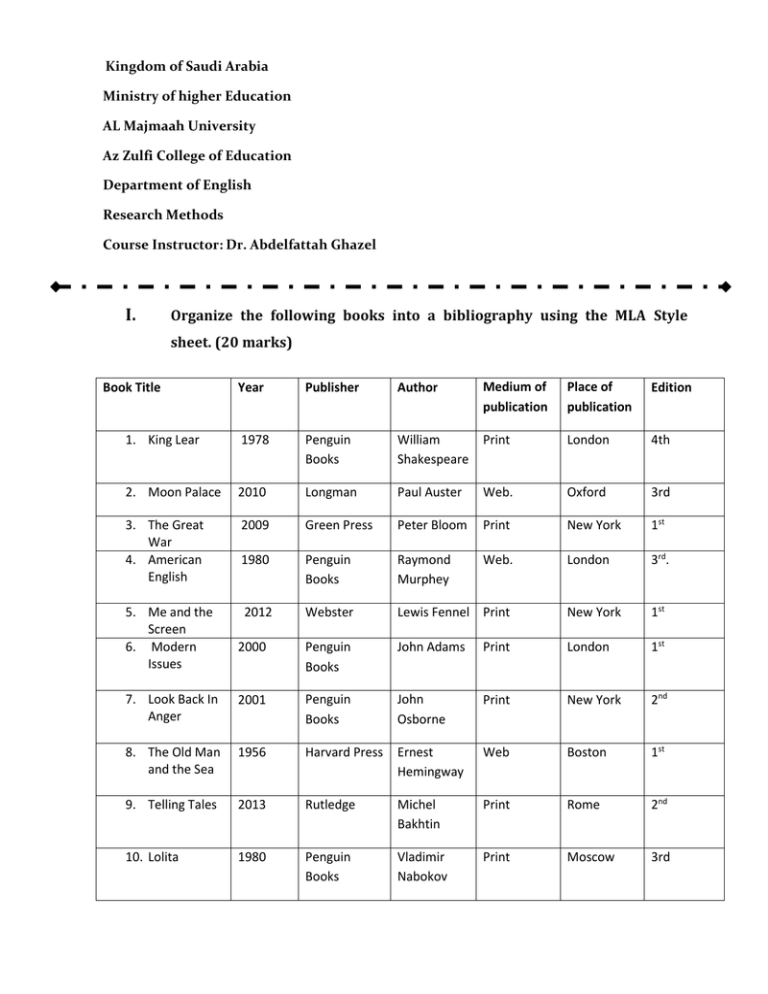
Kingdom of Saudi Arabia Ministry of higher Education AL Majmaah University Az Zulfi College of Education Department of English Research Methods Course Instructor: Dr. Abdelfattah Ghazel I. Organize the following books into a bibliography using the MLA Style sheet. (20 marks) Year Publisher Author Medium of publication Place of publication Edition 1. King Lear 1978 Penguin Books William Shakespeare Print London 4th 2. Moon Palace 2010 Longman Paul Auster Web. Oxford 3rd 3. The Great War 4. American English 2009 Green Press Peter Bloom Print New York 1st 1980 Penguin Books Raymond Murphey Web. London 3rd. 5. Me and the Screen 6. Modern Issues 2012 Webster Lewis Fennel Print New York 1st 2000 Penguin Books John Adams Print London 1st 7. Look Back In Anger 2001 Penguin Books John Osborne Print New York 2nd 8. The Old Man and the Sea 1956 Harvard Press Ernest Hemingway Web Boston 1st 9. Telling Tales 2013 Rutledge Michel Bakhtin Print Rome 2nd 10. Lolita 1980 Penguin Books Vladimir Nabokov Print Moscow 3rd Book Title Answers 1…………………………………………………………………………………………………………… …………………………………………………..………………………………………………………… 2…………………………………………………………………………………………………………… …………………………………………………..………………………………………………………… 3…………………………………………………………………………………………………………… …………………………………………………..………………………………………………………… 4…………………………………………………………………………………………………………… …………………………………………………..………………………………………………………… 5…………………………………………………………………………………………………………… …………………………………………………..………………………………………………………… 6…………………………………………………………………………………………………………… …………………………………………………..………………………………………………………… 7……………………………………………………………………………………………………………. …………………………………………………………..…………………………………………………. 8……………………………………………………………………………………………………………. …………………………………………………………..…………………………………………………. 9……………………………………………………………………………………………………………. …………………………………………………………..…………………………………………………. 10……………………………………………………………………………………………………………. …………………………………………………………..…………………………………………………... II. In the following bibliography, there is ONE mistake in every title find the mistake and correct it. ( 2 marks x5 =10 marks) 1. Cohn, Dorrit. The Distinction of Fiction. Baltimore: Johns Hopkins Univ. Press, 1999. Web. 2. Connor, Steven. Rewriting Wrong: On the Ethics of Literary Reversion. London, OUP, 1989. Print. 3. Defoe, Daniel. Robinson Crusoe. Edited by John Richetti. Penguin books: London, 4th ed, 2001. Print. 4. Gallagher, Susan VanZanten. A Story of South Africa: J. M. Coetzee’s Fiction in Context. Cambridge: Harvard Univ. Press, Print,1991. 5. Gallagher, Susan VanZanten. Narrating Narrating: Twisting the Twice-Told Tale: Berlin: Gutenberg Press, 2nd edition, 2010. Web. III. MLA documentation: in-text citations . ( 2 marks x5 =10 marks) Circle the letter of the MLA in-text citation that is handled correctly. 1. The student is quoting from page 26 of the following source: Hawley, Richard A. Thinking about Drugs and Society: Responding to an Epidemic. New York: Walker, 1988. Print. a. Richard A. Hawley reports that although the ancient Chinese used marijuana for medical purposes, “there is no record of the Chinese using it as a pleasure-producing drug” (26). b. Richard A. Hawley reports that although the ancient Chinese used marijuana for medical purposes, “there is no record of the Chinese using it as a pleasure-producing drug.” (26) 2. The student is summarizing information from page 63 of the following source: Henningfield, Jack E., and Nancy Almand Ator. Barbiturates: Sleeping Potion or Intoxicant? New York: Chelsea, 1986. Print. a. Drugs classified as Schedule I by the Drug Enforcement Administration are illegal, even for medical purposes, but they are allowed in authorized experiments (Henning-field 63). b. Drugs classified as Schedule I by the Drug Enforcement Administration are illegal, even for medical purposes, but they are allowed in authorized experiments (Henningfield and Ator 63). 3. The student is citing a statistic that appeared in the following unsigned article: “Cross-Eyed and Painless.” Economist 6 July 1991: 89. Print. a. Nearly half of 1,035 oncologists surveyed in 1991 said that if smokable marijuana were legal for cancer patients, they would prescribe it (Economist 89). b. Nearly half of 1,035 oncologists surveyed in 1991 said that if smokable marijuana were legal for cancer patients, they would prescribe it (“Cross-Eyed” 89). 4. The student is quoting from page 79 of the following source: Marshall, Eliot. Legalization: A Debate. New York: Chelsea, 1988. Print. There are two works by Marshall in the list of works cited. a. Marshall explains that marijuana can be dangerous for people with heart conditions because its use “can dramatically increase heart rate and blood pressure” (Legalization 79). b. Marshall explains that marijuana can be dangerous for people with heart conditions because its use “can dramatically increase heart rate and blood pressure” (79). 5. The student is quoting from page 67 of the following source: Marshall, Eliot. Legalization: A Debate. New York: Chelsea, 1988. Print. There are two works by Marshall in the list of works cited. a. The US Drug Enforcement Administration has allowed marijuana to be used in experiments with patients suffering from glaucoma. According to one expert, “Several studies since 1971 have shown that smoking marijuana causes the pressure within the eye to decrease and to remain at a lowered level for about five hours” (Legalization 67). b. The US Drug Enforcement Administration has allowed marijuana to be used in experiments with patients suffering from glaucoma. According to one expert, “Several studies since 1971 have shown that smoking marijuana causes the pressure within the eye to decrease and to remain at a lowered level for about five hours” (Marshall, Legalization 67). 6. The student is quoting from page 8 of the following article: Hecht, Brian. “Out of Joint: The Case for Medicinal Marijuana.” New Republic 15 July 1991: 7-9. Print. a. Brian Hecht sums up the debate over the medical use of marijuana in three questions: “(1) Is the drug safe? (2) Does it work? and (3) How does it compare with other available drugs” (8)? b. Brian Hecht sums up the debate over the medical use of marijuana in three questions: “(1) Is the drug safe? (2) Does it work? and (3) How does it compare with other available drugs?” (8). 7. The student is citing page 13 of the following article, written by six authors, from an online scholarly journal: Campbell, Fiona A., et al. “Are Cannabinoids an Effective and Safe Treatment Option in the Management of Pain? A Qualitative Systematic Review.” BMJ 323.7303 (2001): n. pag. Web. 6 Mar. 2005. a Fiona A. Campbell et al. summarize the results of scientific studies on the effectiveness and safety of using marijuana for medical purposes. b Fiona A. Campbell summarizes the results of scientific studies on the effectiveness and safety of using marijuana for medical purposes. All The Best
